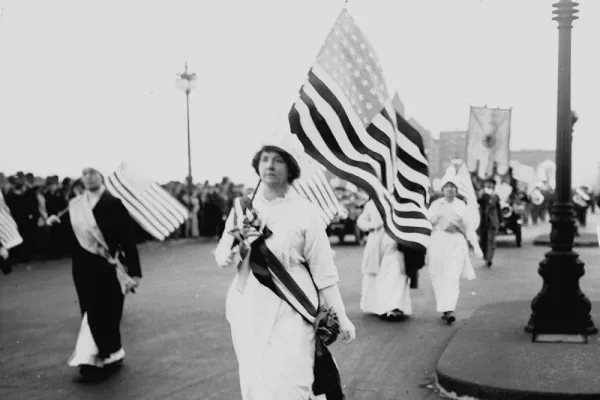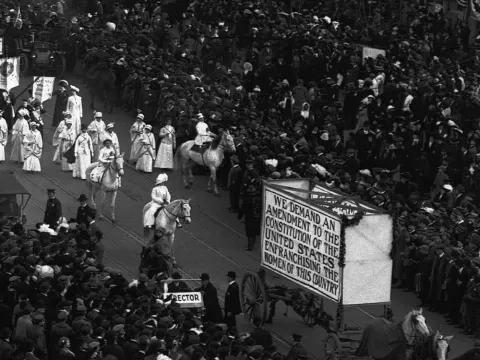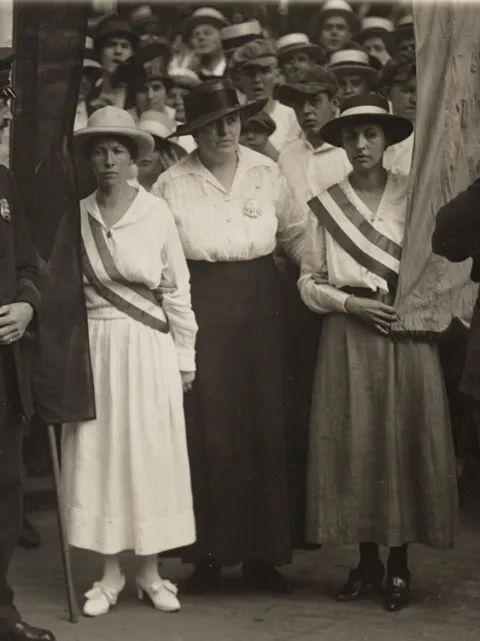100 Years of Suffrage
Campus Life

Published September 21, 2020
Women argued, protested and took to the streets as they fought for the right to vote. They were arrested and jailed. Some were beaten. Others risked their marriages and their standing in the community. They were talked down to and demeaned. In opposing women’s suffrage, former President Grover Cleveland in 1905 referred to women’s “enduring frailties” and impractical minds. In the end, after a long, bitter struggle, women across America gained the guarantee that states could no longer limit their right to vote.
The fight, whose outcome was never assured, ended on August 18, 1920, when the state of Tennessee became the 36th state to ratify the 19th Amendment. The momentous victory, however, would not fully extend to all American women until decades later, when another landmark decision—the Voting Rights Act of 1965—blocked states from discriminating at the ballot box on account of race or color.
The campaign for voting rights for women began in 1848, when Elizabeth Cady Stanton and Lucretia Mott convened the first women’s rights convention in Seneca Falls, New York. Smith College opened its doors in 1871, and alumnae from Smith’s earliest classes got on board. The class of 1888 boasted in class notes in a 1912 Quarterly that it “was very glad and proud” to play a leading role in California’s suffrage campaign. Blanche Ames Ames 1899, a prominent activist in the birth control movement, supported the fight for a national amendment. Minerva Crowell Wexler 1901 joined thousands of women in the infamous 1913 march in Washington, D.C., at which scores of women were hospitalized for injuries, and which was staged the day before Woodrow Wilson’s inauguration. Suffragist leader Bernice Secrest Pyke 1902 was the first woman to run for mayor in her hometown of Lakewood, Ohio, and in 1920 was the first woman elected as a delegate to the Democratic National Convention.
After a bitter 72-year struggle, women across America gained the guarantee that states could no longer limit their right to vote.
Back on campus, Smith students in 1912 petitioned the faculty to form a suffrage club, saying “that since Smith College aims toward developing broad-minded, educated women, the students of the college should take a definite interest in a problem which is of such world-wide social and economic importance.” The faculty granted their petition to form a Suffrage Discussion Club, with the proviso that President Marion LeRoy Burton approve any outside speakers the students would bring in.

The day before Woodrow Wilson’s 1913 inauguration, thousands of women paraded in Washington, D.C., to demand nationwide suffrage.
Enfranchising women would lead the country in a new, and unknown, direction, and not all women were certain about its consequences. Dean Ada Comstock 1897 wrote in 1909, in the first issue of the Quarterly, of being at once attracted to and repelled by the suffrage argument. She writes of her desire to “go to Congress, to sit upon the Supreme Bench (and upon juries, too, for that matter)” or to serve as secretary of state. And yet, she writes, “Neither in I myself nor in any woman I know do I detect superior fitness for such labors; and I can find it in my craven soul to be forever content to leave the machinery of government … in the hands of men.” Comstock ends her column by throwing up her hands and saying, “I dunno.”
In the hundred years since gaining the vote, women have made significant strides by exercising their franchise. Progress to achieve equal representation in Congress and other legislative bodies has been frustratingly slow; the presidency in this election cycle is once again out of reach, but perhaps this will be the year that the title of vice president will be followed by a woman’s name. In the stories that follow, Smith alumnae and faculty members reflect on the power of the vote to move the country forward and also on the work that remains to be done, as we enter the second hundred years.
This story appears in the Fall 2020 issue of the Smith Alumnae Quarterly.

Powered by Women’s Votes: Reflections on a century of progress and reform, but also betrayals and roadblocks.
Because They Persisted: Long struggle for women’s suffrage documented in interactive web app.
‘She Was My North Star’: Great-granddaughter celebrates a pioneering champion for the rights of women and children.
Girl Power: For decades, Camp Marbury, founded by a Smith music professor and his suffragist wife, was a haven for budding feminists.
Suffrage parades suggest a genteel struggle for votes for women. The reality was far more brutal, drawn out and diverse as women were jailed, beaten and mocked. Photographs courtesy of Getty Images